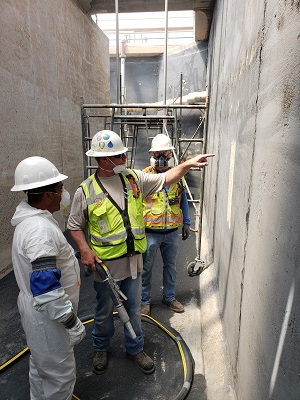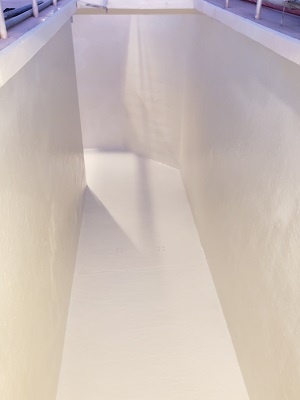Scorpions, swamp coolers, and snowbirds. Oh my!
When a wastewater facility in Rio Verde, Ariz., started leaking and the previous coal tar epoxy started peeling off, it needed to be shut down for a rehab. Owned by EPCOR Water out of Canada, this project was anything but Arctic. Luckily for the local 15-person crew from Degan Construction, they knew how to handle the charms of the desert.
More Power!
Members from both the coatings and concrete divisions comprised this Degan crew. Before they arrived on site, the client had emptied the two aeration chambers on the north side of the facility, which totaled 12,000 square feet (1,114.8 m2) of concrete with steel supports. Led by Coatings Division President Eric Ogren, access wasn’t a main concern like it would have been with a job much farther from Degan’s Phoenix headquarters just 40 minutes away. And once they were on site, the client gave them an area “that we could carve out that was our own,” Ogren said.
Entering the chambers meant needing to use equipment for confined spaces, which on this project required harnesses, self-retracting lifelines, and an arm rescue system. Normal personal protective equipment (PPE) included steel-toed boots, gloves, Tyvek suits, and gas detectors.
The crew started by power washing all surfaces at 4,000 psi (27.6 MPa). “Because the condition the coal tar was in, we were hoping the psi would eat through some of the coal tar, but it did not,” Ogren explained. “You do have to remove all contaminants from the surface prior to [coating] or even prepping before you’d start patching or anything like that.”
Power washing didn’t remove all of the original epoxy, so the crew took prep up a notch by using blasting machines from Clemco with copper slag. They took it up yet another notch when the medium grit wasn’t enough by increasing it to heavy grit — something Home Improvement’s Tim “The Toolman” Taylor would have been happy about! “More power,” anyone?
 According to Ogren, the prep stage was “really difficult, especially when we had to contain for air quality. And, once you start hitting it with that blasting machine, I mean it just clouds up immediately. So you’re kind of working in the dark, you’re blind when you’re working.” To take the “edge off” of that visibility issue, the crew used a wet ring around the containment — similar to misting or swamp coolers used by home- and restaurant owners on a hot day — along with two large evaporative coolers. Not only did that setup help weigh the contaminants down, but it also helped drop the temperatures, which were hot, hotter, and hottest!
According to Ogren, the prep stage was “really difficult, especially when we had to contain for air quality. And, once you start hitting it with that blasting machine, I mean it just clouds up immediately. So you’re kind of working in the dark, you’re blind when you’re working.” To take the “edge off” of that visibility issue, the crew used a wet ring around the containment — similar to misting or swamp coolers used by home- and restaurant owners on a hot day — along with two large evaporative coolers. Not only did that setup help weigh the contaminants down, but it also helped drop the temperatures, which were hot, hotter, and hottest!
The project started at the end of August and ended in mid-October. The crew had a few days of 115 °F (46.1 °C) heat, and the cooling system brought those down about 20 °F (to about 35 °C), according to Ogren. The crew also moved shift times to accommodate those challenges, doing prep work in the daytime and coating work at night.
Getting the Bugs Out
The crew had one unexpected experience on this project. After they got down to the substrate, it was evident that the concrete in particular wasn’t in as good a condition as they initially thought. “Once we got in there and got all the coal tar removed, the condition was a lot worse than we expected and so from the initial bid phase, our quantities were thrown way off,” he said.
Unfortunately, that threw the crew off as far as materials available to use on site. Epoxytec materials come from the company’s site in Florida, so receiving additional material from 2,000+ miles (3,218.7 km) away before the snowbirds returned wasn’t possible. That forced Ogren to think on his feet, and they found an “alternate” product in Sika that they could get in town. Therefore, one chamber was coated in the Epoxytec products, while the second was covered with Sika.
 To start the system, the crew trowel-applied the patchwork with Sika 123 and Epoxytec Ceramico, respectively, and then they used a spray rig by Graco to apply the full coats. The equipment was put together by Spray-Quip in Houston. “We’ve got a real close relationship with those guys,” Ogren said. They sprayed the Sika Armatec – 110 and Epoxytec CPP Sprayliner materials each to a total average of 125 mils (3,175.0 microns).
To start the system, the crew trowel-applied the patchwork with Sika 123 and Epoxytec Ceramico, respectively, and then they used a spray rig by Graco to apply the full coats. The equipment was put together by Spray-Quip in Houston. “We’ve got a real close relationship with those guys,” Ogren said. They sprayed the Sika Armatec – 110 and Epoxytec CPP Sprayliner materials each to a total average of 125 mils (3,175.0 microns).
One thing that was expected for this Arizona-based crew were their smaller dessert-dwellers: scorpions. “You know, we’re in Arizona, so you have to deal with those kinds of nasty bugs,” Ogren said. The crew is used to dealing with these buggers. They know they can’t doff their hard hat or gloves and leave them on the hot concrete and expect it to be scorpion free. “You have to turn [PPE] upside down and shake them out just in case,” he continued. “You’ve got to be careful. You take it for granted sometimes, but when you get lazy is when you get stung.”
Constant Learning
Although many members of the Degan crew have 15 to 20 years of experience, this was the company’s first time working on aeration chambers. Luckily, they had a stellar inspector on site to guide them.
“The inspectors were very helpful. They really helped a lot,” Ogren said of Industrial Inspection and Coating LLC. Ogren was sure to mention to the inspectors that this was the contractor’s first time working on these types of projects (a lot of their past work has been on manholes). And the result? “They were absolutely fantastic,” he said. “I mean, they were tough. They were really tough, but we learned a lot from them. Usually inspectors come out and they just keep their mouths shut, they just look around, and then all of a sudden you get blasted on a report or something, but these guys were very hands on, very knowledgeable, very nice.”
This project also precipitated Degan to hire an employee certified with NACE’s Coating Inspector Program (CIP). They hired someone with a NACE level 2 — waiting on his level 3 — and “he’s been really helpful, too,” Ogren said.
The client was clearly happy with the outcome of the month-and-a-half project. According to Ogren, this project covered the north side of the facility, and Degan Construction has since been called back to work on the south side in just a few months. “By the end of summer, we’ll be doing the same thing all over again,” Ogren said. That’s a testimonial for the team for sure!